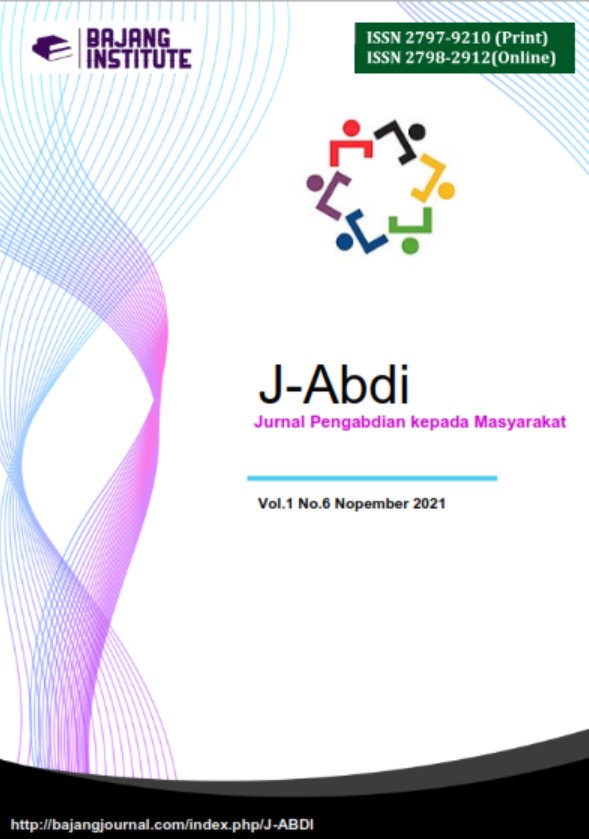PELATIHAN SANITASI TOTAL BERBASIS MASYARAKAT (STBM) STUNTING DI KALURAHAN ARGODADI KAPANEWON SEDAYU KABUPATEN BANTUL YOGYAKARTA
DOI:
https://doi.org/10.53625/jabdi.v1i6.539Keywords:
Community-Based Total Sanitation; CLTS; StuntingAbstract
Community-Based Total Sanitation is an approach and paradigm of sanitation development in Indonesia that emphasizes maximizing community empowerment through triggering to increase behavior change, especially behavior change in terms of sanitation. In addition to nutritional conditions, poor environmental factors related to drinking water and sanitation can also increase the risk of stunting. There is a very close relationship between poverty, access to drinking water, and sanitation and the incidence of stunting. One of the efforts to integrate the acceleration of nutrition improvement through stunting prevention, since 2017 various pieces of training involving nutrition and environmental health officers have begun to be provided. The addition of an output indicator of 3 stunting pillars so that currently there are 8 STBM-Stunting pillars. The material was delivered using the principles of adult learning, followed by simulation and practice of triggering the STBM pillar. Participants were health cadres and the stunting prevention team of Argodadi Village. Through practical simulations in training, then health cadres are expected to be able to trigger STBM-stunting. In the final session as a follow-up plan, the cadres agreed on a commitment to conduct similar training in their respective hamlet areas
References
Adriany, F., Hayana, H., Nurhapipa, N., Septiani, W., & Sari, N. P. (2021). Hubungan Sanitasi Lingkungan dan Pengetahuan dengan Kejadian Stunting pada Balita di Wilayah Puskesmas Rambah. Jurnal Kesehatan Global, 4(1), 17–25. https://doi.org/10.33085/jkg.v4i1.4767
Dinas Kesehatan DIY, D. K. D. (2018). Orientasi STBM Stunting. https://www.dinkes.jogjaprov.go.id/berita/detail/sanitasi-stunting-stbm-orientasi-stbm-stunting
Dirjen Kesehatan Masyarakat, M. (2018). Modul Pelatihan Fasilitator Sanitasi Total Berbasis Masyarakat STBM - Stunting. In Dirjen Kesehatan Masyarakat Kemenkes RI. http://siakpel.bppsdmk.kemkes.go.id:8102/akreditasi_kurikulum/modul_2101251046196d3ab791b8fac2d52467d335a9683ace.
Ichwanudin, H. K. (2019). Cegah Risiko Stunting Melalui 5 Pilar STBM. Http://Pamsimas.Org. http://pamsimas.org/cegah-risiko-stunting-melalui-5-pilar-stbm/
Kemenkes RI. (2018). Buletin Stunting. Kementerian Kesehatan RI, 301(5), 1163–1178.
Kementerian Kesehatan RI. (2013). Peraturan Menteri Kesehatan tentang Pedoman Pelaksanaan dan Pembinaan Pemberdayaan Masyarakat Bidang Kesehatan. In BN.2013/NO.1318, KEMKES.GO.ID : 4 HLM. https://peraturan.bpk.go.id/Home/Details/129749/permenkes-no-65-tahun-2013
Menteri Perencanaan Pembangunan Nasional/Kepala Bappenas. (2020). Penyampaian Perluasan Lokasi Fokus Intervensi Stunting Terintegrasi. 2.
Sampul, M., Ismanto, A., & Pondaag, L. (2015). HUBUNGAN DIARE DENGAN KEJADIAN MALNUTRISI PADA BALITA DI IRINA E BAWAH RSUP PROF. Dr. R. D. KANDOU MANADO. Jurnal Keperawatan UNSRAT, 3(1), 110574.
Sekretariat STBM, S. S. (2018). Tentang STBM. Http://Stbm.Kemkes.Go.Id. http://stbm.kemkes.go.id/app/about/1/about
Yuni. (2017). Stunting : Dalam Kacamata Kesehatan Lingkungan. Http://Stbm.Kemkes.Go.Id. http://stbm.kemkes.go.id/app/news/11651/stunting-dalam-kacamata-kesehatan-lingkungan
Zairinayati, R. P. (2019). Hubungan Hygiene Sanitasi dan Lingkungan dengan Kejadian Stunting Pada Balita. Jurnal Ilmiah Multi Science Kesehatan, 10(1), 78–91.














